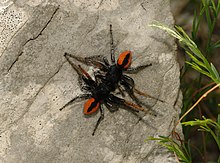Golden-eyed jumping spider
| Golden-eyed jumping spider | ||||||||||||
|---|---|---|---|---|---|---|---|---|---|---|---|---|

Golden- eyed jumping spider ( Philaeus chrysops ), male |
||||||||||||
| Systematics | ||||||||||||
|
||||||||||||
| Scientific name | ||||||||||||
| Philaeus chrysops | ||||||||||||
| ( Poda , 1761) |
The golden- eyed jumping spider ( Philaeus chrysops ) is a spider from the jumping spider family (Salticidae).
features
Females and males are up to 12 millimeters long. Like many jumping spiders, the species shows a clear sexual dimorphism in terms of color and markings: the male is conspicuously colored, his abdomen ( opisthosoma ) is bright brick red with a black point on the tip, the front body ( prosoma ) is black. The two front pairs of legs are partly orange, the two rear pairs of legs are gray. The female is gray-brown in color.
distribution and habitat
The species is distributed over much of the southern Palearctic . The distribution area runs from west to east from Spain and France to northern China (east to the provinces of Shanxi and Hebei ). It is also found sporadically in southern China. It is absent in the north, for example in Poland it can only be found in eight smaller areas in the south of the country. However, it is also native to southern Russia including southern Siberia up to the 53rd parallel .
A coherent distribution area in which the golden-eyed jumping spider occurs quite frequently in some places is formed by southern and southeastern Europe and the entire Mediterranean region .
North of the main Alpine ridge , however, it can only be found in a few, isolated areas in which the individual populations have only a few individuals. In Germany there are such dry and warm locations mainly in the Upper Rhine Plain , for example at the Kaiserstuhl . Other places in southern Germany are sunny slopes on the Franconian Alb . In Austria, finds were reported from the Oberinntal and Ötztal , as well as from Upper Austria (Kreuzmauer near Ternberg ) others from the eastern edge of the Alps at the transition to the Vienna Basin , for example Hohe Wand , as well as from the Mur-Mürz-Furche and the Grazer Bergland .
The golden-eyed jumping spider mainly lives in dry areas with little vegetation. It can be found on sandy, stony or rocky surfaces, but it also climbs bushes and trees.
Way of life
The species loves warmth and is diurnal, it eats insects that it actively catches.
When mating, the males occasionally have conspicuous mock battles with one another. The male mates when it meets a female about to molt. Before that, the female is courted with courtship dances, the male stands up, stretches out his front legs and waves with the first pair of legs, moving back and forth. If the female accepts the advertisement, she stops and is mated by the male. The female builds a web sack for the egg cocoon under stones and guards the eggs. After hatching, the young are still blind, only after the second moult do they have fully developed eyes.
Danger
The dry-warm (xerothermal) locations preferred by the golden-eyed jumping spider, e.g. B. rocky, sunny grasslands or limestone slopes with bushes are in decline in Central Europe, because the landscape is no longer kept open. Many individual finds over the past few decades could have come from populations that have since become extinct. The species is therefore classified in the Red List in Germany as "critically endangered" (Category 1). In Germany it is one of the arachnids that are strictly protected according to Appendix 1 of the Federal Species Protection Ordinance.
literature
- Barbara Baehr and Martin Baehr: Which spider is that? The most famous species in Central Europe. With a special section: Exotic and poisonous spiders in the world. 2nd edition, Kosmos Naturführer, Franck Kosmos, 2002, page 54 ISBN 3-440-09210-0
- Heiko Bellmann: Cosmos Atlas Arachnids of Europe. 3rd edition, Franckh-Kosmos, Stuttgart 2006, pp. 200-239 ISBN 3-440-10746-9
- K. Gauckler: Gold-eyed jumping spider and vermilion tube spider in Northern Bavaria. Communications of the Natural History Society Nuremberg, 6, pp. 51–55, 1971
Web links
Golden-eyed jumping spider in the World Spider Catalog
- Philaeus chrysops at Fauna Europaea
- Philaeus chrysops on the Arachnological Society e. V.
- Golden- eyed jumping spider on natureview.ch (with pictures)
Individual evidence
- ↑ Description at worldwide database of jumping spiders (Arachnida, Araneae, Salticidae) by Heiko Metzner (German)
- ↑ JM Marusik, DV Logunov, S. Koponen: Spiders of Tuva, South Siberia. Russian Academy of Sciences, Far East Branch, North-East Scientific Center, Magadan 2000, p. 100 full text ( memento of the original from March 8, 2016 in the Internet Archive ) Info: The archive link was inserted automatically and has not yet been checked. Please check the original and archive link according to the instructions and then remove this notice. (PDF; 6.9 MB)
- ^ Frances Murphy and John Murphy: An Introduction to the Spiders of South East Asia. Malaysian Nature Society, Kuala Lumpur 2000, p. 279
- ↑ Philaeus chrysops Polska Czerwona Księga Zwierząt (Red List of Poland) (English)
- ↑ Barbara Baehr and Martin Baehr: Which spider is that? The most famous species in Central Europe. With a special section: Exotic and poisonous spiders in the world. 2nd edition, Kosmos Naturführer, Franck Kosmos, 2002, p. 54
- ↑ G. Deschka: The jumping spider Philaeus chrysops in Upper Austria. (Arachnida: Salticidae). Contributions to Upper Austria's natural history, 9, pp. 187–190, 2000. Full text (PDF, German; 407 kB)



